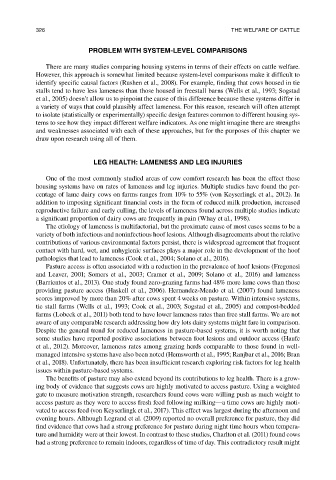Page 349 - The Welfare of Cattle
P. 349
326 the WeLfare of CattLe
PrOBLeM WIth SYSteM-LeVeL COMParISONS
There are many studies comparing housing systems in terms of their effects on cattle welfare.
However, this approach is somewhat limited because system-level comparisons make it difficult to
identify specific causal factors (Rushen et al., 2008). For example, finding that cows housed in tie
stalls tend to have less lameness than those housed in freestall barns (Wells et al., 1993; Sogstad
et al., 2005) doesn’t allow us to pinpoint the cause of this difference because these systems differ in
a variety of ways that could plausibly affect lameness. For this reason, research will often attempt
to isolate (statistically or experimentally) specific design features common to different housing sys-
tems to see how they impact different welfare indicators. As one might imagine there are strengths
and weaknesses associated with each of these approaches, but for the purposes of this chapter we
draw upon research using all of them.
LeG heaLth: LaMeNeSS aND LeG INJUrIeS
One of the most commonly studied areas of cow comfort research has been the effect these
housing systems have on rates of lameness and leg injuries. Multiple studies have found the per-
centage of lame dairy cows on farms ranges from 10% to 55% (von Keyserlingk et al., 2012). In
addition to imposing significant financial costs in the form of reduced milk production, increased
reproductive failure and early culling, the levels of lameness found across multiple studies indicate
a significant proportion of dairy cows are frequently in pain (Whay et al., 1998).
The etiology of lameness is multifactorial, but the proximate cause of most cases seems to be a
variety of both infectious and noninfectious hoof lesions. Although disagreements about the relative
contributions of various environmental factors persist, there is widespread agreement that frequent
contact with hard, wet, and unhygienic surfaces plays a major role in the development of the hoof
pathologies that lead to lameness (Cook et al., 2004; Solano et al., 2016).
Pasture access is often associated with a reduction in the prevalence of hoof lesions (Fregonesi
and Leaver, 2001; Somers et al., 2003; Cramer et al., 2009; Solano et al., 2016) and lameness
(Barrientos et al., 2013). One study found zero-grazing farms had 48% more lame cows than those
providing pasture access (Haskell et al., 2006). Hernandez-Mendo et al. (2007) found lameness
scores improved by more than 20% after cows spent 4 weeks on pasture. Within intensive systems,
tie stall farms (Wells et al., 1993; Cook et al., 2003; Sogstad et al., 2005) and compost-bedded
farms (Lobeck et al., 2011) both tend to have lower lameness rates than free stall farms. We are not
aware of any comparable research addressing how dry lots dairy systems might fare in comparison.
Despite the general trend for reduced lameness in pasture-based systems, it is worth noting that
some studies have reported positive associations between foot lesions and outdoor access (Haufe
et al., 2012). Moreover, lameness rates among grazing herds comparable to those found in well-
managed intensive systems have also been noted (Hemsworth et al., 1995; Ranjbar et al., 2016; Bran
et al., 2018). Unfortunately, there has been insufficient research exploring risk factors for leg health
issues within pasture-based systems.
The benefits of pasture may also extend beyond its contributions to leg health. There is a grow-
ing body of evidence that suggests cows are highly motivated to access pasture. Using a weighted
gate to measure motivation strength, researchers found cows were willing push as much weight to
access pasture as they were to access fresh feed following milking—a time cows are highly moti-
vated to access feed (von Keyserlingk et al., 2017). This effect was largest during the afternoon and
evening hours. Although Legrand et al. (2009) reported no overall preference for pasture, they did
find evidence that cows had a strong preference for pasture during night time hours when tempera-
ture and humidity were at their lowest. In contrast to these studies, Charlton et al. (2011) found cows
had a strong preference to remain indoors, regardless of time of day. This contradictory result might

